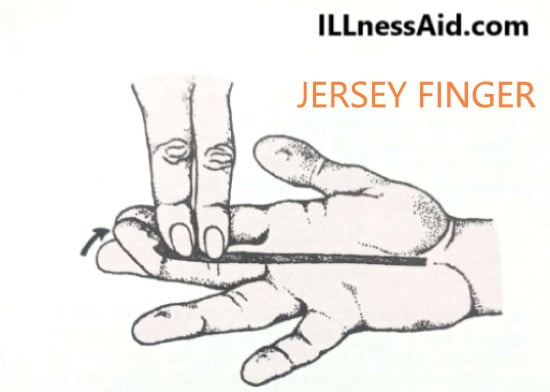Jersey finger is the avulsion/rupture of the flexor digitorum profundus. In which the patient is not able to flex the distal interphalangeal joint(DIP). It can occur in any digit, But it is most common in the ring finger. This injury usually occurs when an athlete grabs an opponent’s jersey and feels sudden pain as the finger is forcibly extended( hyperextension stress applies to a flexed finger).

CLINICAL FEATURES
There are many clinical features of the jersey finger that can confirm your diagnosis. Now let’s discuss them:
- Lack of active flexion of the DIP joint means FDP function loss
- Not able to bend one or more joints in the finger
- Often show swollen finger
- Retraction of the FDP tendon back into the palm side denotes the force avulsion
- Numbness, rip sensation, pain in fingertip and around palm also
STAGES OF JERSEY FINGER INJURY
There are 3 stages described by Leddy and packer(1997) of jersey finger and later 2 stages have been added. So, there are 5 stages and these are based on “where avulsed tendon retracts” let’s discuss them:
- TYPE I: Retraction of FDP (flexor digitorum profundus) tendon to the palm
- TYPE II: Retraction to the proximal interphalangeal joint
- TYPE III: Avulsion of bony fragment and that bony fragment retract to the A4 pulley
- TYPE IV: It is simultenous avulsion of FDP from fracture fragment
- TYPE V: It is a significant fracture of the distal phalanx
Stage Type I to Type III are the ones which describe firstly and Type IV and V describe later.
TREATMENT FOR JERSEY FINGER
Treatment of FDP avulsion is primarily surgical. The success of the treatment depends on the severity of the injury. Tendon with minimal retraction has significant attached avulsion bone fragments, which can reattach bone to bone. Tendon with a large amount of retraction has no bone fragment, and should not make the surgical repair more than 10 days because of retraction and the longer healing time of the weaker nonbone to bone fixation. so after the surgical treatment let’s talk rehabilitation phase in detail:
REHABILITATION PHASE
0-10 Days
- Dorsal blocking splint(DBS) the wrist at 30 degrees flexion, the MCP joint at 70 degrees flexion, and the PIP and DIP joints in full extension.
- Gentle passive DIP and PIP joint flexion to 40 degrees within dorsal blocking splint.
- Suture removal at 10 days.
10 Days-3 Weeks
- Place into a removable DBS with the wrist at neutral and the MCP joint at 50 degrees(flexion).
- Gentle passive DIP joint flexion to 40 degrees, PIP joint flexion to 90 degrees within DBS.
- Active MCP joint flexion to 90 degrees.
- Active finger extension of IP joints within dorsal blocking splint, 10 repetitions per hour.
3-5 Weeks
- Discontinue DBS (5-6 weeks).
- Active/assisted MCP/PIP/DIP joint ROM exercises.
- Begin place-and-hold exercises.
5 Weeks+
- Strengthening/power grasping.
- Progress activities.
- Begin tendon gliding exercises.
- Continue PROM, and scar massage.
- Begin active wrist flexion/extension.
- Composite fist and flex wrist and then extend wrist and fingers.
REHABILITATION PHASE (With Purely Tendinous Repair or Poor Bony Repair)
0-10 Days
- Dorsal blocking splint the wrist at 30 degrees flexion and the MCP joint at 70 degrees flexion.
- Gentle passive DIP and PIP joint flexion to 40 degrees within DBS.
- Suture removal at 10 days.
10 Days-4 Weeks
- Dorsal blocking splint the wrist at 30 degrees flexion and the MCP joint at 70 degrees flexion.
- Gentle passive DIP joint flexion to 40 degrees, PIP joint flexion to 90 degrees within Dorsal blocking splint(DBS), passive MCP joint flexion to 90 degrees.
- Active finger extension within dorsal blocking splint(DBS).
- Remove pull-out wire at 4 weeks.
4-6 Weeks
- DBS the wrist neutral and the MCP joint at 50 degrees of flexion.Passive DIP joint flexion to 60 degrees, PIP joint to 110 degrees, and MCP joint to 90 degrees.
- Gentle place-and-hold composite flexion.
- Active finger extension within DBS.
- Active wrist ROM out of DBS.
6-8 Weeks
- Discontinue daytime splinting, night splinting only.
- Active MCP/PIP/DIP joint flexion and full extension.
8-10 Weeks
- Discontinue night splinting.
- Assisted MCP/PIP/DIP joint ROM.
- Gentle strengthening.
10 Weeks +
- More aggressive ROM.Strengthening/power grasping.
- Unrestricted activities.
BE ATTENTIVE, BE CAREFUL, BE HEALTHY
ILLnessAid
Thank you for reading this far, Today we talk about jersey finger. If you have any doubts regarding this you can comment below or go on the contact us page.

